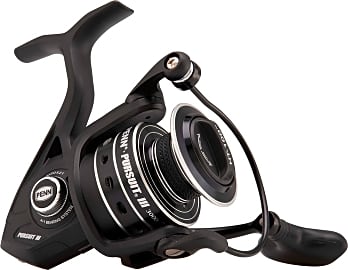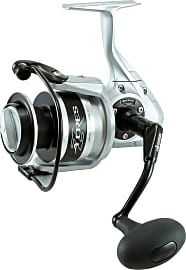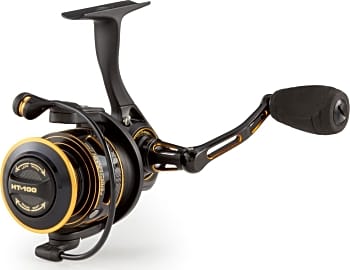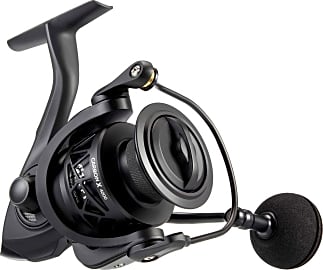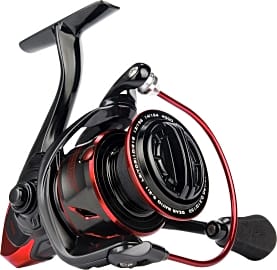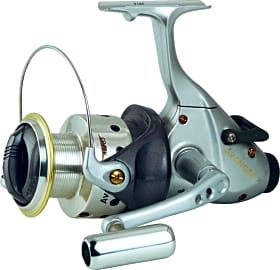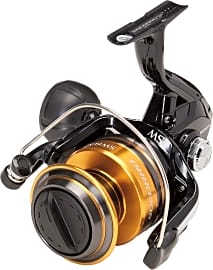The 10 Best Saltwater Spinning Reels

This wiki has been updated 35 times since it was first published in January of 2017. The conditions for saltwater fishing are often more challenging and dynamic than they are for inshore or freshwater angling. The species you’re targeting are typically bigger and stronger, and the corrosive air wreaks havoc on metal components. Choose from these specially designed spinning reels to overcome these obstacles and land the big one you've always dreamed of. When users buy our independently chosen editorial recommendations, we may earn commissions to help fund the Wiki.
Editor's Notes
December 09, 2020:
The Runcl Grim and Penn Spinfisher are both no longer available, so they’ve been removed from the list.
The Penn Clash resists breaking down, even when regularly exposed to moisture and salty air, thanks to a sturdy body that’s protected by an impervious seal. Its finish is quite durable as well, so the appearance shouldn't suffer from minor scrapes and impacts. We mentioned that the Daiwa BG also features durable housing that does a reliable job of protecting its internal components from the elements.
To replace the eliminated items, we added the Piscifun Carbon X and Penn Pursuit III — both sharp-looking black reels known for combining a lightweight design with impressive power. We’d like to point out that the Penn model is nearly silent while casting and reeling in, though you’ll of course be able to easily hear the drag when it’s activated by a strong fish. The Piscifun reel is a good value for beginners and budget-minded fishermen; it performs better than you’d expect given its reasonable price.
April 15, 2019:
After users noted its inability to withstand saltwater effectively, the description of the Yongzhi Ultra was updated to reflect that it should only be used in freshwater environments. For this reason, we eliminated it from the list. We moved the Runcl Grim up in the rankings after multiple users noted that it offers the durability, reliable drag system, and smooth retrieval that you’d expect from a high-end model, albeit at a much more affordable price.
There was a newer version of the Penn Spinfisher available, so we updated the list accordingly. While a few users still lament the fact that it’s a bit heavier than many similar models, there are consistent reports that it’s expertly built to resist water intrusion, with tight seals and a corrosion-resistant body. It’s also powerful, both in terms of casting and max drag.
Added the Shimano Baitrunner D, which is geared mostly toward intense saltwater anglers. It’s fairly pricey, but users seem to really appreciate its versatility, as on one hand, the drag can be adjusted to adequately handle huge fish, and on the other hand, it’s still fun to catch small ones on its opposite setting.
Special Honors
Tica Wily Available in a black, red or white design, this surf fishing reel allows you to cast for great distances and retrieve smoothly with its extra-long handle (which can be used interchangeably on the left or right side). A special guard helps prevent the line from getting stuck behind the spool, too. ticafishing.com
Canyon Salt Canyon’s line of Salt spinning reels provide powerful drag, a completely sealed body, and durable stainless steel ball bearings. The 5000 model can hold more than 350 yards of 65-pound line, and the 7500 model even features a useful port for lubricating the gear assembly. canyonreels.com
Some Reels Can Handle Saltwater; Some Can't
Experienced saltwater fishermen who recognize the connection are nodding their heads in agreement.
Instead of attempting to analyze the explicit differences between freshwater and saltwater fishing, try to keep it simple.
Let’s say you’re an avid biker. If you live somewhere with a mild climate and relatively flat topography, you’ll probably look to invest in a reasonably lightweight, aerodynamic bicycle that requires as little maintenance as possible. On the other hand, someone in a region with more rugged terrain and colder temperatures will want a bike built with tough, durable components, thicker tires, and a heavier frame.
Experienced saltwater fishermen who recognize the connection are nodding their heads in agreement.
Due to the corrosive qualities of saltwater, these reels are — as a rule — constantly subjected to harsher environments than their freshwater counterparts. Therefore, you need to make sure the spinning reel you purchase is designed with strong materials that will help bolster its resistance to corrosion.
Carbon fiber, stainless steel, and aluminum are suitable options for the reel itself, but make sure to check on the construction of other vital elements of the unit, such as the frame and the spool. You’ll often find that these parts are made of graphite because it’s lightweight and inexpensive, but keep in mind that it’s not quite as resilient as the alternatives mentioned above.
Magnesium is a popular material for freshwater spinning reels, but saltwater anglers will want to avoid it. It won't take long before a magnesium reel begins to rust, and it will only to continue to deteriorate as you keep fishing with it in those conditions. Titanium, which is also lightweight, is a more durable option.
While saltwater does wreak havoc on certain items, it sure creates a friendly habitat for a vast array of fish species. If you’re a fisherman who enjoys going after the big boys — such as sharks, marlins, and different types of tuna — you need a reel with a high-performance drag system that’s powerful enough to maintain smooth line and proper tension even as it bears significant weight.
Your Gear Should Match Your Angling Style
Inshore anglers in search of trout, flounder, and redfish lurking in relatively shallow water near land will probably require a slightly different type of real than offshore fishermen interested in landing giant roosterfish and snapper in deep offshore areas.
As offshore fishermen tend to throw heavier baits in an attempt to lure monsters out of the depths, they usually benefit from a little more heft on their reels than typical inshore fishermen.
As a general rule of thumb, try to put together a list of high-quality options, and go with the lightest-weight model that will meet your requirements.
This is a delicate game, however; even a couple ounces of extra weight can markedly increase the amount of stress your arms, wrists, and shoulders must endure through hours of fishing. As a general rule of thumb, try to put together a list of high-quality options, and go with the lightest-weight model that will meet your requirements.
One aspect people often overlook is gear ratio, which measures how many times the bail rotates through the spool each time you turn the reel handle. For example, a reel with a 4:1 gear ratio (four rotations per handle turn) provides ample torque for reeling in large fish, while a 6:1 ratio allows for a speedier retrieval when you’re fishing for lightweight species.
This is why it’s important to keep your preferred fishing style in mind, and that does not apply exclusively to the type of fish you’re targeting — your fishing method is important to consider, as well.
Jigging, casting, trolling, and bottom fishing all require a significantly different approach, and some reel models are designed specifically for certain techniques. Make sure you think about this as you go over the fine details in the descriptions when you’re researching brands
Saltwater Angling Over The Ages
Artwork suggests that people in ancient civilizations used some form of a fishing pole with a reel, but the exciting spinning reels we enjoy today didn’t appear in North America until the 1870s. They emerged as a lightweight alternative to the bait casting reel, making it much easier to use small lures like flies and artificial baits.
Saltwater fishing, long considered more dangerous than freshwater fishing, gained popularity in the late 19th century, particularly in the United States, Australia, and New Zealand. Early adopters discovered that artificial baits — similar to those used by European trout and salmon fishermen — could successfully hook large ocean fish like tuna.
Marlins proved so difficult to land, in fact, that it wasn’t until 1903 that a fisherman using a rod and reel successfully pulled one into a boat.
Saltwater fishing for sport established itself as a mainstream American pursuit during the subsequent decades, and even found its way into pop culture. The famed author Ernest Hemingway, a passionate fisherman himself, regaled readers with his exploits on the high seas, a great example of which is his short novel The Old Man and the Sea.
Even in the early days, saltwater fishermen consumed themselves with seeking out billfish — a category of fish that includes sailfish, swordfish, and different types of marlins.
Because these large species are incredible fighters, anglers relished the challenge of catching a trophy. Marlins proved so difficult to land, in fact, that it wasn’t until 1903 that a fisherman using a rod and reel successfully pulled one into a boat.
Unfortunately, saltwater fishing hasn't been all fun and games. Most species of big game fish — we’re talking both saltwater and freshwater — are in decline across the world, and have been for some time. Much of this is due to issues like pollution and climate change, but commercial and sport fishing shoulder plenty of the blame, as well.
A variety of conservation organizations in the United States and internationally have spearheaded initiatives to combat this disturbing trend. Similar to the “catch and release” tactic freshwater fishermen often employ, it has become common practice for saltwater anglers to use a “tag and release” method, which helps experts conduct research on species that are in danger and track the movements of different types of fish.



